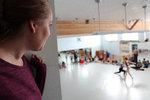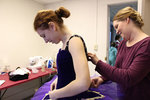

Wendy Hill has never wanted a place in the spotlight.
Yet, every time a dancer takes the Corbet Theatre stage during “The Nutcracker,” her work shines.
As costume mistress for the Southwest Washington Dance Center, Hill oversees the creation, care and upkeep of the estimated 225 costumes needed for the show. For Hill, being part of the unseen army of volunteers who make the stage production possible is right where she wants to be.
“I like the back end of watching the performance and I do love the kids,” Hill said. “I love to be part of the backstage part of it.”
Hill got involved at the dance center when her daughter, Delanie, fell in love with dance as a preschooler. She said she began helping with costumes about 10-12 years ago when she mentioned to someone that she knew how to sew. Hill is a professional hairdresser but her grandmother taught her to sew when she was about 10, and it is a talent she enjoys using. She said helping at the dance center has given her an outlet for her creativity.
“I love working with Danielle (Brosco, artistic director), she’s super super creative and I love, love, love making her stuff come to life, and I feel privileged to be part of it,” Hill said.
Like the principal dancers in “The Nutcracker,” Hill’s work actually begins in July or August, when she and Brosco meet to discuss any new costumes for the year. In about September, she begins fittings. Every dancer is fitted for every costume they will wear, and adjustments and repairs are made as needed
“Every single one of them, they all get fit,” Hill said. “Sometimes they’re super excited and sometimes they don’t want to wear it,” she said.
She said Brosco sometimes needs new costumes for changing scenes or wants existing costumes modified in some way. Each year they try to replace a few of the older costumes. This year, Hill was tasked with replacing the costumes for the Harlequin scene as well as building new costumes for a new giant toy scene that was added.
But Hill’s most challenging project to date was this year’s replacement of the Sugar Plum Fairy tutu. This required her to learn how to make a pancake tutu. Also known as the classic tutu, the pancake tutu is one of the premiere styles of performance tutus. They are best known for their many layers of crinoline (6-10 usually), which make the skirt almost defy gravity by remaining perfectly straight out, even when the dancer is moving.
“They are the tour de force of tutus,” Brosco said. “How amazing is that? I have someone who is sewing these tutus for us?”
Professional companies pay as much as $1,000-$2,000 for these tutus and since the dance center is nonprofit, its budget could not afford such an expense. Former costumer, Rosie Breen, had made the pancake tutus for some of the principal dances about 12 years ago. Hill, who became lead costumer about seven years ago, said she had noticed they were starting to sag and decided it was time to figure out how to replace them.
“Our budget is really small so buying a $1,000 tutu is not in our budget,” Hill said.
Hill took an online course on how to make a pancake tutu and made a practice specimen before diving into the new Sugar Plum Fairy look. She was able to pick the material up for about $200-$300 in New York’s fashion row on a trip to the city and estimated the finished product will take her at least 40-50 hours of work.
“It’s a lot of hand sewing that goes into this,” she said.